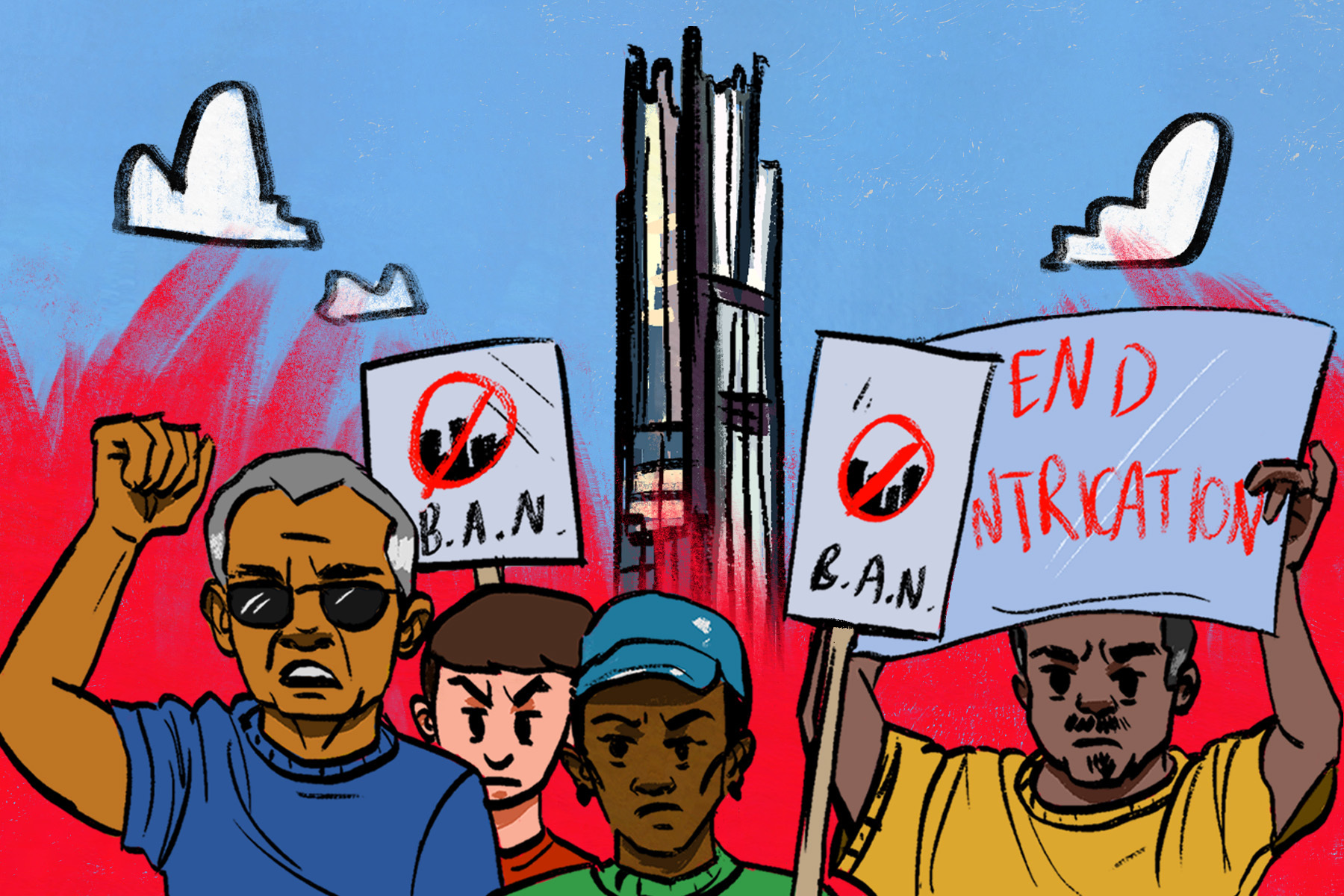The Dime Savings Bank Headquarters in Brooklyn is one of New York’s many hidden architectural gems. Its ornate, Greek Revival facades and elegant interior are marvelous to behold, and its designation as a New York City landmark following its closure and abandonment in 2002 is an affirmation of its historical contributions. It lies off the beaten path for most tourists, yet its location and visual style are remarkably significant to the identity of the borough it inhabits.
It lies near the intersection of DeKalb and Flatbush, the latter a major thoroughfare that traverses some of New York’s most vibrant and diverse neighborhoods. Within a mile radius of the building are the brownstone row houses of the 19th century, the cultural epicenter of Bedford-Stuyvesant and the elegance of old Prospect Park. Simply put, the bank lies at the intersection of all things quintessentially Brooklyn.
Few people stop to observe the Dime Savings Bank Building in the present day, however, and even fewer will do so in the coming months as the staggeringly tall Brooklyn Tower is completed immediately adjacent to it later this year. Stretching 1,066 feet into the New York sky, the building will not only become the borough’s tallest structure but one of the tallest residential towers in the entire nation. The ultramodern façade of the tower feels otherworldly when viewed alongside the quaint bank building, and the visual clash is a perfect representation of their relationship.
It was only through historical preservation and community input that the extant walls of the bank survived demolition during the construction process, yet the old structure is nonetheless rendered inconsequential because of the architectural work that has overshadowed it in a quest to redefine the borough’s image. The tower, known also by its street address, 9 DeKalb, is a foray into high-density luxury development, which is novel to Brooklyn yet far from groundbreaking.
The Brooklyn Tower’s staggering height causes it to stand out from the other structures of Brooklyn’s downtown, though it is far from the first building of its kind in the city. Across the East River in Midtown Manhattan lies a residential district that has served as a failed experiment in super-tall residential development. Nestled along the streets that house Carnegie Hall and the MoMA are a collection of apartment towers, notoriously known as Billionaire’s Row.
The units housed within these buildings have sold for exorbitant prices, yet despite the sales, the buildings have high vacancy rates due to many being purchased by foreign nationals who never intend to reside in the city. The often unknown, ultra-wealthy buyers purchase the expensive real estate to dump a portion of their cash assets through the transactions, often for ethically dubious reasons.
The speculative investments hurt native New Yorkers by artificially shrinking the housing market and weakening the local economy since foreign unit owners are not able to patronize nearby businesses as permanent residents could. The questionable outcomes of these Manhattan developments have raised broad skepticism concerning the validity of building more super-tall luxury structures, and many fear that 9 DeKalb will bring the disease of Billionaire’s Row to Brooklyn.
Rental prices for the tower have not yet been released, yet the unit prices on the apartments for sale are relatively high and establish the building as an affluent enclave. Studio units start at around $900,000, whereas four-bedroom apartments can cost upwards of $6 million. The building’s floor space is filled to the brim with amenities, many of which fill needs that are traditionally met by municipal resources. The Brooklyn Tower includes a basketball court, swimming pool, fitness center, movie theater and outdoor green space among other amenities, with the public restricted from accessing these features.
Basketball courts and parks are traditionally funded by city governments for the public good, whereas retail spaces for theaters or gyms are traditionally at street level and made available to all. There is an unfortunate psychological consequence associated with placing once-public amenities behind the barrier of income-based privilege, for it conditions tower occupants to become increasingly disconnected from or indifferent to the people and communities they live alongside.
Michael Stern, one of the building’s developers, offered an unintentionally poignant summation of the principle when describing the building’s stunning views: “The price of admission to the observation deck? You’ve got to buy or rent a unit.” Callousness toward the social change inflicted by gentrification is ultimately one of the most tragic consequences of modern urban renewal; it sends the message that the reality on the ground is undeserving.
An interactive map of New York’s neighborhoods published by Bloomberg in 2017 demonstrates the stability of the displacement trend wherein wealthy white residents move into many gentrifying communities while people of color move out. The two neighborhood zones closest to 9 DeKalb lost 27,439 Black and Hispanic residents between 2000 and 2015 while gaining 43,793 white residents.
The unfortunate reality of these figures lies in the net population growth in Brooklyn; the city can accommodate locals and transplants. High-density developments like the Brooklyn Tower could potentially offset the displacement trend, yet their lack of affordable units prevents low-income residents from remaining in their neighborhoods. The inherently exclusive nature of super-tall residential developments has not slowed the rate of their construction, but there are many alternatives that promote a greater degree of urban sustainability and equity.
Many affordable housing developments have provided those who cannot afford the expensive luxury units a strong alternative that does not compromise on amenities or material quality. Via Verde, located in the rapidly gentrifying South Bronx, provides dozens of affordable units for middle or low-income New Yorkers in spaces that are furnished with market-rate materials. The site offers an abundance of green spaces including a ground-level communal area and terraced roof gardens that allow residents to harvest food for the community.
Across the river in Harlem, the Sugar Hill development provides rental units with similarly high-quality designs and includes a gallery for the works of local artists and a childhood center for the building’s youth. These two examples are significant not only for ensuring that communal resources may be enjoyed regardless of income but also for their ability to cater to longtime residents.
Both the South Bronx and Harlem are majority nonwhite neighborhoods that have been subject to gentrification in recent years. Via Verde and Sugar Hill have not directly reduced the influx of new residents, but they have prevented a rapid displacement along demographic lines by providing longtime residents with affordable housing that approximates the quality of market-rate developments.
The Brooklyn Tower is undoubtedly the most prominent example of urban displacement and gentrification in Brooklyn, yet the development’s website paints a picture devoid of this reality. Besides marketing the convenient location and sleek interiors of the apartments, the site highlights many local businesses and artistic institutions, including many that are BIPOC or women-owned. The site’s robust depiction of a vibrant and diverse Brooklyn packages the tower as a positive contribution to this environment, masking the defects of gentrification behind a thin veneer of progressivism. The sanitized image the advertising presents is intentional, and the illusion it creates is relatively easy to maintain.
Gentrification is rarely an openly violent or blatantly obvious process, and one building alone should not be held responsible for years of community erasure. The greatest danger posed by the tower is the potential for forthcoming development inspired by its success, spawning a secondary wave of urban renewal.
Ultimately, the nearby Dime Savings Bank Building tells the full story of contemporary Brooklyn that 9 DeKalb cannot. The bank building, like the borough’s authenticity, has remained intact despite facing adversity, though the changing skyline has threatened to render it a mere shell of its original, vibrant self.

















